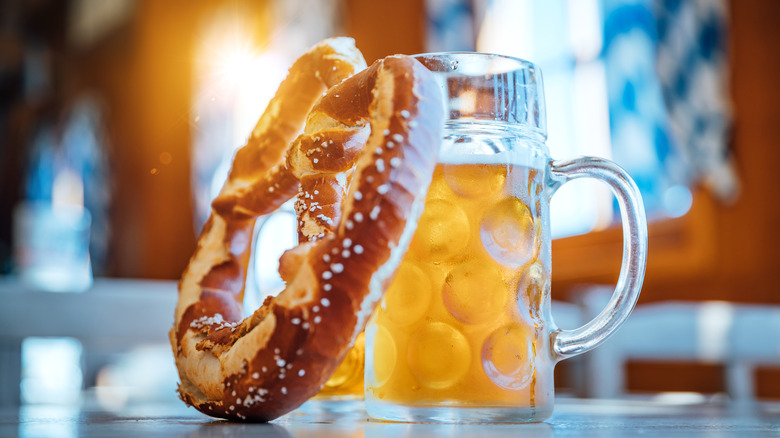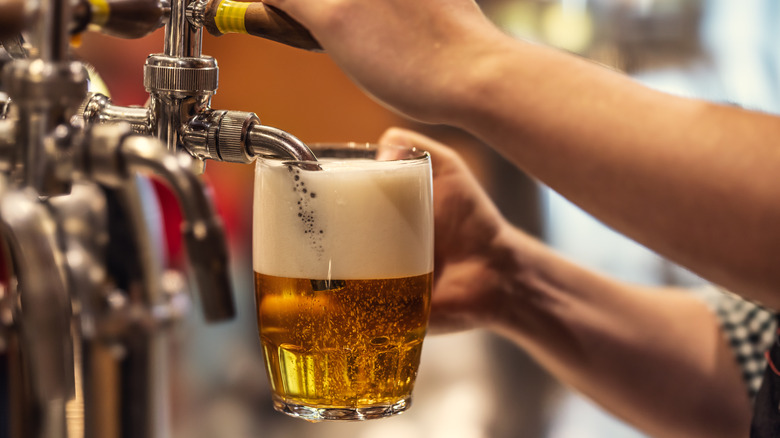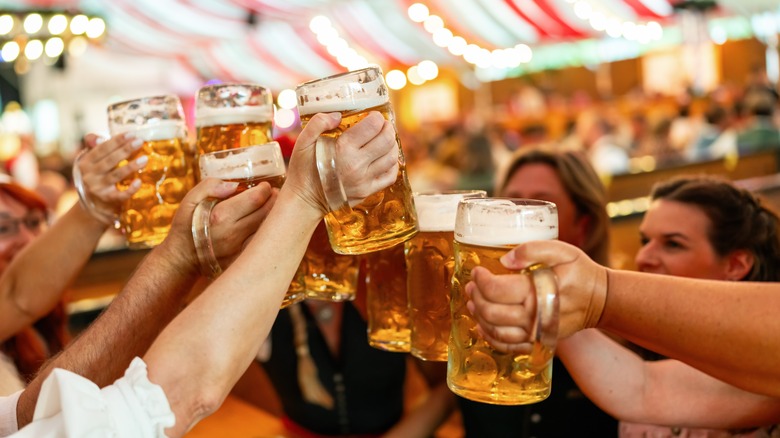What The Heck Is Oktoberfest Beer And How Is It Unique?
From the second week in September to the first Sunday in October, Oktoberfest is in full swing, which means it's time to break out the lederhosen and brush up on your German. The festival was first celebrated in 1810 in the Bavarian region of Germany to commemorate a royal wedding, and included five days of horse races, folk singing, and beer ... lots of beer. Over the years, Oktoberfest has become a more general celebration of German culture and food that's recognized around the world.
Among the many neat facts about Oktoberfest, one is that during the yearly festivities in Munich, partygoers strictly enjoy official "Oktoberfest beers" served by only six designated breweries. What defines an Oktoberfest beer can be a bit complicated, however, especially because there are other brews — mostly American beers — that are labeled as "Oktoberfest-style." These two categories actually have vastly different appearances and flavor profiles.
In addition to hailing from an approved Oktoberfest brewery, an official Oktoberfest beer has to be a lager — a style of beer that is aged for months at a temperature between 32 to 45 degrees Fahrenheit, allowing the yeast to sink to the bottom of the tank while fermenting. This makes the beer lighter and more crisp and refreshing. The exact flavor profiles vary, but most of the beer enjoyed during Oktoberfest is pale or amber in color, and tastes similar to other traditional German lagers like Dortmunder, which has a malt-forward, "hoppy" flavor with an undertone of bitterness.
Only six breweries serve beer at the official Oktoberfest
It wouldn't be Oktoberfest without a sausage in one hand and a beer in the other, and the only draughts that are allowed to be served at the festival in Germany come from the breweries Paulaner, Spaten, Hacker-Pschorr, Augustiner, Hofbrau, and Lowenbrau. That's because back in 1516, Germany passed a Beer Purity Law that limited ingredients to barley, hops, and water. Because of this, only the breweries listed above were allowed to participate in the festivities, as they adhered to the new rules. While the Purity Law is no longer enforced, the official Oktoberfest still honors the tradition's origins. While Oktoberfest offshoots in other countries likely won't have these unique Munich-based brews on tap, beer lovers who can't make it out to Germany can have these official "Oktoberfestbiers" imported.
Besides official Oktoberfest brews, other beers have earned the title of "Oktoberfest-style," allowing revelers around the world to get a taste of the action. American Oktoberfest-style beers are especially popular, but beer drinkers may notice large differences in appearance and flavor. This difference is due to the evolution of Oktoberfest beer brewing over the years, resulting in less malty, lighter beers that are higher in carbonation levels, making them easier to drink in bigger volumes. Most American Oktoberfest-style beers actually favor an old-fashioned German brewing process, creating a darker style.
Oktoberfest-style beers differ from the modern kind in many ways
Most beers enjoyed at American Oktoberfests are Marzens, a more obscure style of lager. What makes a beer a Marzen is a unique aging process that starts in March and extends until fall, just in time for the Oktoberfest celebration. This brewing process is considered the traditional style of brewing, dating back to when Oktoberfest first began.
However, official Oktoberfest beers have evolved in color and flavor, as breweries have slightly altered their style to include paler malts and a higher gravity. This creates a higher alcohol content, between 5.8% and 6.3% ABV, compared to Americanized Marzen beers that range from 5.1% to 6.0%. Americanized Oktoberfest beers are also usually a dark amber color and tend to have a richer, full flavor of sweet malt, toasty notes, and a bread-like aroma that can present as herbal or even spicy.
Most seasonal Oktoberfest-style beers served in the U.S. will display "Oktoberfest-style" or "Marzen-style" on their label. But some American beer companies have come around to the more modern take, and can be found labeled under "German-Style Oktoberfest" or "Wiesn." While the two are vastly different experiences from a flavor point of view, both look great in a frosted glass and pair perfectly with a pretzel and a brat.



